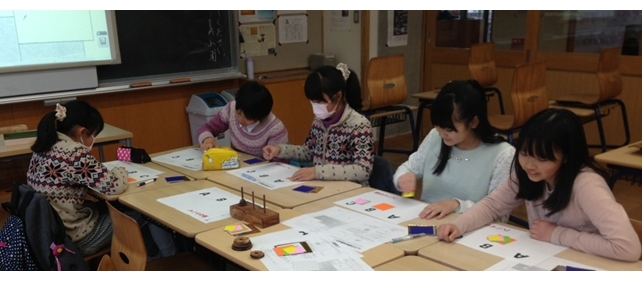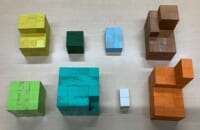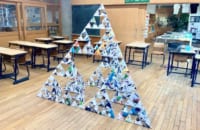本日5月23日を523と3ケタの数で表すと、523は素数です。西暦を含めた20180523は3×11×611531と素因数分解されるので、素数ではありません。
皆さんは、「ハノイの塔」というゲームを知っていますか。世界中で人気のあるゲームです。今回は、このゲームと数学の関連をご紹介します。もちろん、「ハノイの塔」は数学メディアスペースに置いてあります。
このゲームは、以下のルールに従って、すべての円盤を最初の杭(くい)から残り2本どちらかの杭に移動させられれば完成です。
(1)3本の杭と、中央に穴の開いた大きさの異なる複数の円盤がある。
(2)最初は、すべての円盤が左端の杭に小さいものが上になるように順に積み重ねられている。
(3)円盤を1回に1枚ずつどれかの杭に移動させることができるが、小さな円盤の上に大きな円盤を載せることはできない。
何度かやっているうちに、コツがわかってきます。写真では円盤は5枚ですが、最初は3枚からスタートして、最短何回で他の杭に移せるか数えていきましょう。3枚の場合の最短回数は7回です。その後、円盤を1枚ずつ増やしながらやってみましょう。まずは円盤が何枚のときは最短何回で完成することができるか調べてみましょう。実は、このゲームには数学的な規則性や法則があります。
(○+1)枚を移動する最短回数 = ○枚を移動する場合の最短回数 × 2 + 1(回)
(2)円盤○枚を移動する場合の最短回数は、○を使って表すことができます。
○枚を移動する場合の最短回数 = 2○-1(回)
「ハノイの塔」は、フランスの数学者リュカ(1842-1891)が1883年に創作、発売したゲームです。日本でも20世紀初めに紹介されて以来、楽しまれています。ルールが単純なので、誰でも気軽に遊べますね。同中学びプロジェクト(放課後特別企画)では、写真のように円盤を折り紙で代用して楽しみました。
(数学科 園田)


“Tower of Hanoi”
Do you know “Tower of Hanoi”? This game is popular all over the world. We will introduce the connection between this game and mathematics. Of course we have this in our math space.
The goal of the game is to move all the disks on one entire stack to another rod, with the rules below.
(1)Only one disk can be moved at a time.
(2)Each move consists of taking the upper disk from one of the stacks and placing it on top of another stack.
(3)No disk may be placed on top of a smaller disk.
This is the best way to solve the game. Let’s start the game using only 3 disks. The game can be solved in 7 moves with 3 disks. Then please try increasing one by one.
the minimum number of times to move (○+1)
= the minimum number of times to move ○ × 2 + 1
(2)We can express the minimum number of times to move ○ using ○.
the minimum number of times to move (○+1) =2○ – 1
“Tower of Hanoi” is the game which French mathematician Lucas (1842-1891) made and sold in 1883. It was also introduced in Japan at the beginning of the 20th century and became popular. The rules of this game are easy, so anyone can play it. We enjoyed it using origami instead of disks as in the photo at an extra program “Do-chu Manabi Project” that we did after school.
by Tsuyoshi Sonoda (Math Dept.)



